Have you ever wondered how to operate a lathe and where to even begin? Do you feel overwhelmed standing in front of a lathe machine for the first time? Are you eager to learn how to operate a lathe without making mistakes? Do you worry about damaging expensive tools or ruining your valuable workpiece?
To operate a lathe, you begin by securely mounting the workpiece and selecting the correct cutting tool. Next, you set the spindle speed and feed rate based on the material. Then, align the tool with the workpiece and start the machine. Guide the tool along the desired path—whether turning, facing, or threading—while maintaining consistent feed. Always follow safety procedures and check alignment before cutting. Mastering these basic steps is the foundation of safe and effective lathe operation.
This guide covers how to operate both manual and CNC lathes, from setup and tool selection to cutting techniques and safety tips, to help you work efficiently, safely, and accurately.
What Is a Lathe?
Basic Definition and Purpose
A lathe is a powerful and essential machine tool designed to rotate a workpiece along a central axis, allowing a cutting tool to remove material and shape it with precision. If you’re just starting to learn how to operate a lathe, this is the first concept you need to understand—the part spins, and the tool cuts.
The lathe enables a variety of machining processes such as turning, facing, drilling, and threading. It’s widely used to manufacture rotationally symmetrical components such as cylindrical shafts, bushings, precision rings, and threaded fittings, which are common across multiple machining applications. From one-off repairs to mass production in high-tech industries, lathes play a foundational role in machining metal components.
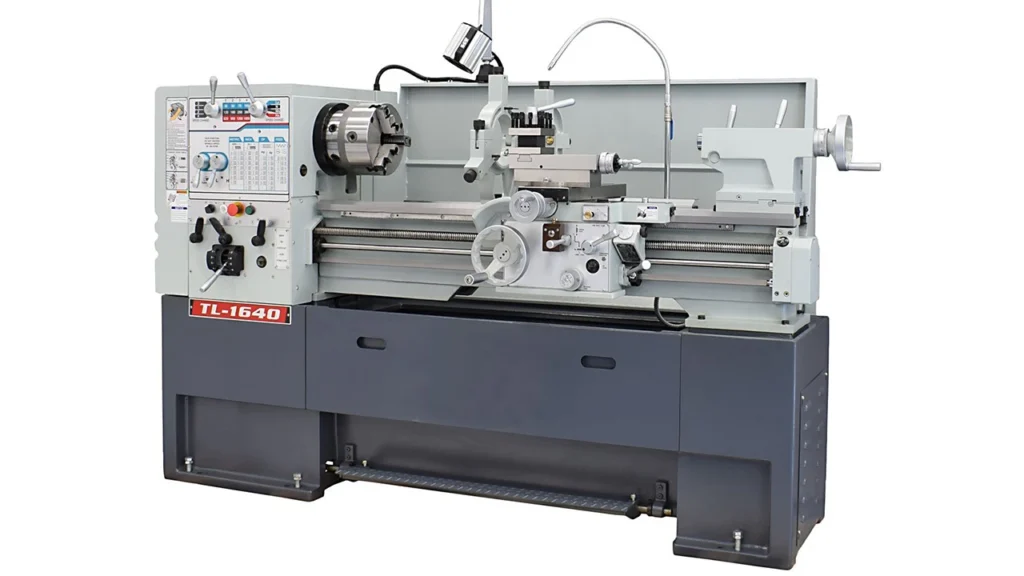
Types of Lathes: Manual vs CNC
Understanding the differences between manual and CNC lathes is critical before you begin. Both machines serve the same purpose but vary significantly in how they are operated.
Manual Lathe Operation
A manual lathe requires hands-on control. You, the operator, manually turn the handwheels, adjust the feed rate, and move the tool post along the workpiece. This gives you full tactile feedback and control over each cut. Manual lathes are great for beginners learning the physical dynamics of machining, as well as for workshops handling custom, low-volume jobs or quick repairs.
CNC Lathe Operation
A CNC (Computer Numerical Control) lathe automates the machining process. It runs based on pre-written G-code programs that define movements, spindle speeds, and tool changes. Once setup is complete, the CNC system controls the process with high precision and repeatability. CNC lathes are ideal for batch production and complex parts, offering unmatched efficiency but requiring programming knowledge.
Which One Should You Start With?
If you’re new to machining, starting with a manual lathe helps you understand the fundamentals—how materials respond, how tools cut, and how speed affects finish. Once you’re confident, moving to a CNC lathe allows you to scale production with automation and precision. This guide will teach you how to operate both, step by step.
Key Applications in Machining Industries
Lathes are used in almost every sector that involves metal processing. Their precision and adaptability make them irreplaceable in both small workshops and large-scale factories.
Automotive Industry
Lathes are used to produce engine components such as crankshafts, camshafts, gear blanks, and hub assemblies. Tight tolerances and surface finishes are critical here, making lathe precision essential.
Aerospace and Medical Fields
In aerospace, lathes machine lightweight and strong parts like turbine shafts and engine housings. In the medical field, they’re used for high-precision titanium implants and surgical tool components that require smooth surfaces and biocompatibility.
Oil & Gas and General Workshops
Pipe threading, bushing production, and large shaft turning are common lathe tasks in the oil and gas sector. In general workshops, lathes are relied on daily for repair jobs, part prototyping, and maintenance machining.
Whether you’re building custom tools or mass-producing precision parts, knowing how to operate a lathe opens up countless opportunities across industries.
Understanding Lathe Components
Overview of Lathe Construction
Before learning how to operate a lathe, it’s essential to understand its major components. Whether it’s a manual lathe or a CNC lathe, the basic structure remains similar. A lathe is built for stability, precision, and smooth movement, and every part plays a key role in the machining process.
A standard lathe consists of several core systems: the headstock, spindle, chuck, tool post, carriage, tailstock, feed system, and in CNC lathes, a control panel. Together, they enable the machine to perform accurate, controlled cutting while securing both the workpiece and the tool.
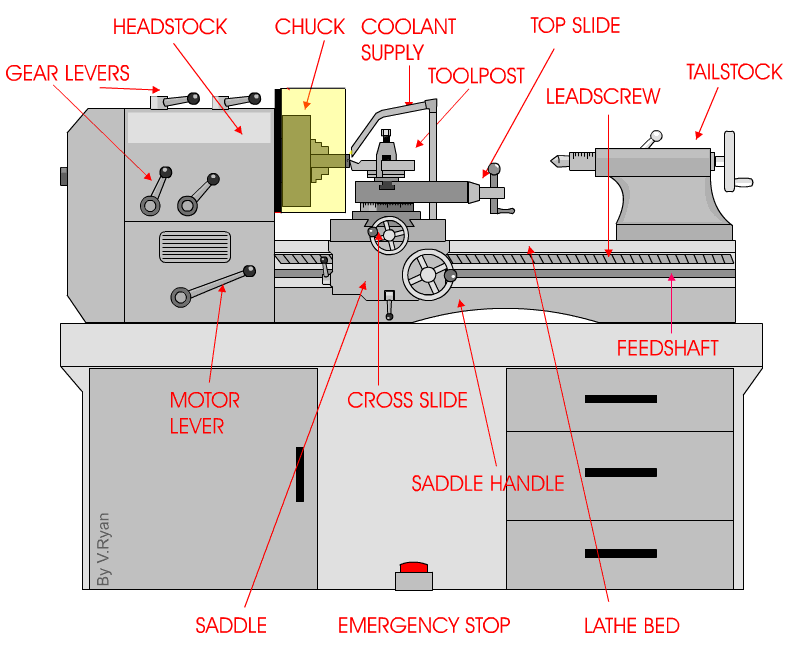
Headstock, Spindle, and Chuck
The headstock is the driving unit of the lathe, located at the left end of the bed. Inside the headstock is the spindle, which holds and rotates the workpiece. The speed of the spindle can be adjusted depending on the material and operation type.
Attached to the spindle is the chuck, the clamping device used to secure the workpiece. There are different types of chucks—3-jaw chucks for general round work, 4-jaw independent chucks for irregular shapes, and collet chucks for high-precision holding of small parts.
In CNC lathes, the spindle speed is controlled electronically via the CNC panel. In manual lathes, spindle speed is usually adjusted through a mechanical gearbox operated by shift levers, allowing the operator to select from predefined speed ranges based on the material and cutting operation.

Tool Post, Carriage, and Tailstock
The tool post is where the cutting tools are mounted. It’s located on the carriage, which slides along the bed in both longitudinal (Z-axis) and transverse (X-axis) directions. The carriage is driven manually or via servo motors in CNC machines.
The tailstock sits opposite the headstock and is used for additional support, especially when machining long shafts. It can also hold drilling or boring tools. In manual lathes, the tailstock is positioned by hand. In CNC lathes, tailstock movement is programmable for automated support.
Together, these components allow controlled cutting, proper alignment, and part stability during turning operations.
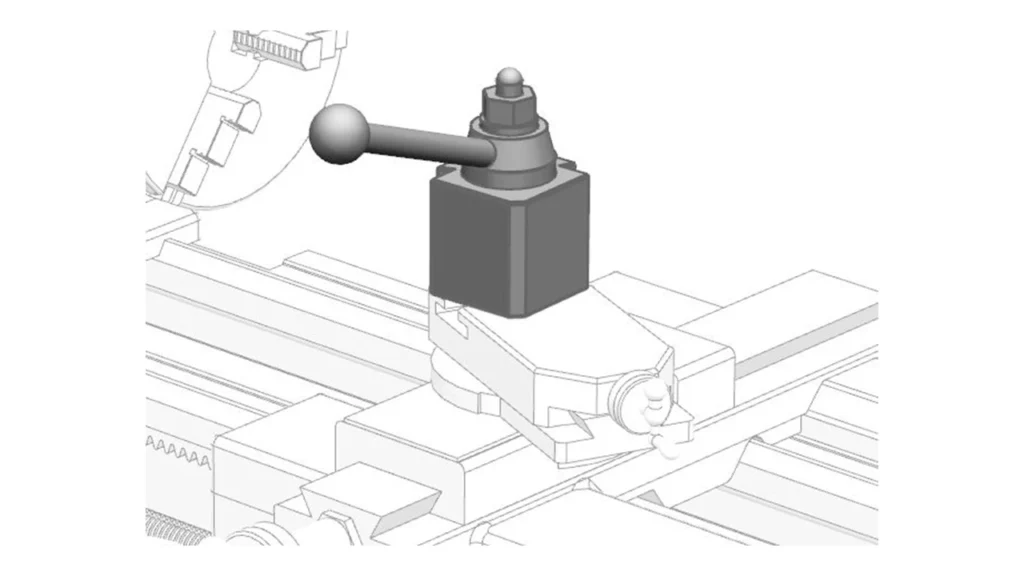
Guideways and Lead Screws
Beneath the carriage and tailstock are the guideways, which are precisely machined tracks integrated into the lathe bed. These hardened rails ensure smooth, straight, and accurate movement of the carriage and tailstock along the length of the workpiece. There are different types of guideways, including flat-bed and dovetail designs, chosen based on machine size, stability, and load capacity.
In manual lathes, the carriage is moved using a lead screw, which converts rotary motion from the handwheel into linear motion. The lead screw is also essential for thread cutting, where the tool must synchronize precisely with the spindle rotation to match the pitch of the thread.
In CNC lathes, traditional lead screws are often replaced or enhanced with ball screws, which offer lower friction, higher accuracy, and long-term durability. These screws are driven by servo motors and controlled through the CNC program, allowing for precise tool positioning, especially during complex contouring or threading operations.
Proper alignment of the guideways and maintenance of the screw systems are vital for ensuring long-term machining accuracy and minimizing tool wear.
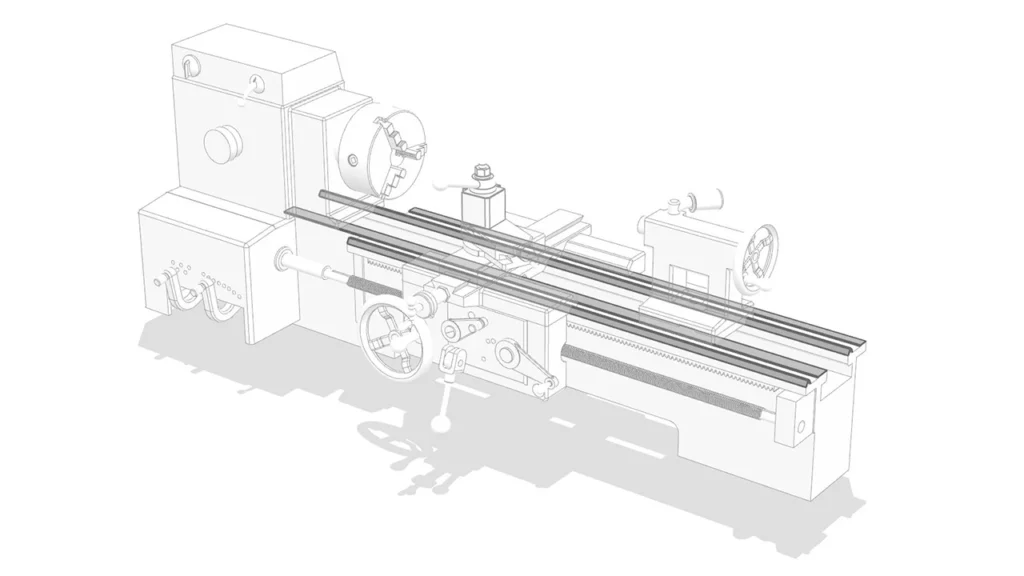
Feed Systems and CNC Control Panel
The feed system controls the movement of the cutting tool relative to the rotating workpiece. In manual lathes, this is operated using handwheels or a feed lever. In CNC lathes, the feed is controlled by precise motorized drives guided by a G-code program.
CNC machines also feature a control panel—this is the brain of the system. It contains the display screen, keypad, emergency stop, and program input interface. Operators can load, modify, and run part programs directly from the panel, allowing repeatable, high-precision machining.
Knowing how each of these components works is a critical first step in learning how to operate a lathe safely and efficiently—because only when you understand your machine, can you truly control it.
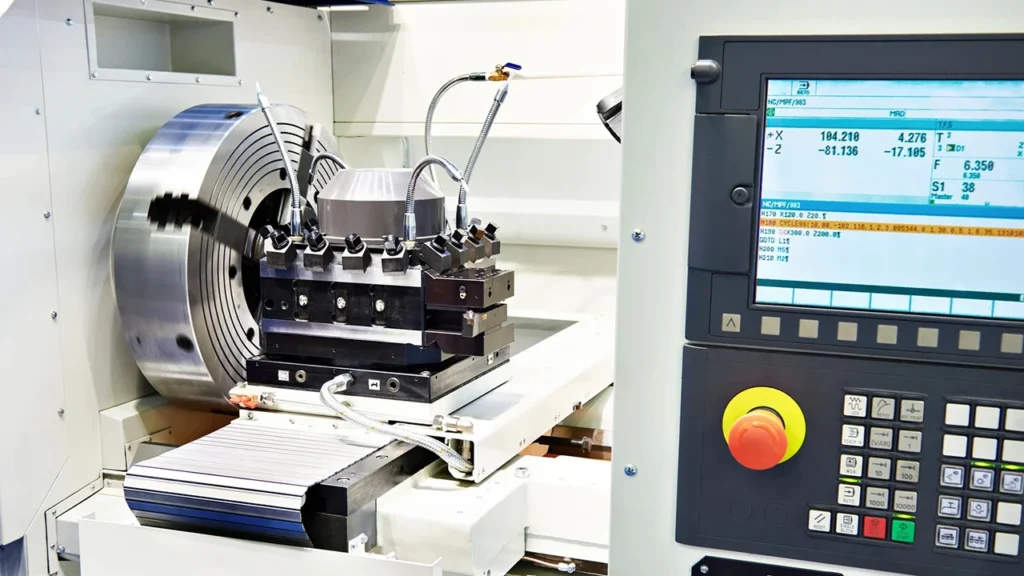
How to Operate a Manual Lathe
Step-by-Step Workflow for Beginners
Operating a manual lathe requires hands-on coordination, attention to detail, and a clear understanding of the process. The goal is to shape a rotating workpiece using a stationary cutting tool while maintaining safety and dimensional accuracy. If you’re just beginning to learn how to operate a lathe, this section will guide you through each essential step.
1. Preparation and Safety Check
Before powering up the lathe, inspect the machine and your surroundings. Clear the workspace of debris, make sure the chuck key is removed, and confirm all tools are secured. Always wear safety goggles, avoid loose clothing or gloves, and ensure emergency stop buttons are functional. Double-check the lubrication system and coolant level if applicable.
2. Mounting the Workpiece
Secure the material in the chuck (typically a 3-jaw or 4-jaw chuck). Use a dial indicator to check for concentricity—this ensures the workpiece rotates evenly. For longer shafts, use the tailstock with a live center to prevent deflection during machining. Tighten the jaws firmly, but avoid over-tightening, which may deform softer materials.
3. Selecting and Installing the Cutting Tool
Choose the correct cutting tool for the operation (e.g., turning, facing, threading). Insert it into the tool post and ensure it’s at the correct height—usually aligned with the lathe’s center axis. Use a center gauge or simple ruler trick to check alignment. Lock the tool post firmly in place.
4. Setting the Spindle Speed
Refer to a surface speed chart to determine the ideal spindle RPM based on your material and tool. Then, use the lathe’s gearbox levers to select the appropriate speed range. For example, when turning aluminum, a higher RPM is required than when turning stainless steel. In manual lathes, spindle speed is usually adjusted through a mechanical gearbox operated by shift levers, allowing precise control.
5. Engaging the Feed and Beginning the Cut
Once the spindle is running, advance the tool slowly using the handwheels. Start with a shallow pass to verify the setup. Monitor chip formation and surface finish. Use the cross-slide (X-axis) for diameter adjustments and the carriage handwheel (Z-axis) for longitudinal feed. Apply cutting fluid if needed to reduce tool wear and improve surface finish.
6. Measuring the Part
After each pass, stop the spindle and use a micrometer or caliper to check your dimensions. Manual turning often requires progressive passes, gradually reaching the final measurement. It’s better to take multiple light cuts than one heavy cut that risks damaging the part or tool.
7. Finishing and Cleaning
Once the part reaches its final shape and dimension, perform a light finishing pass or deburring. Then power off the machine, remove the workpiece, and clean the lathe bed and components thoroughly. Always return tools to their designated positions.
Tips to Avoid Common Mistakes
- Never leave the chuck key in the chuck.
- Always check tool height before cutting.
- Don’t use excessive feed rate or depth of cut.
- Keep hands away from rotating parts at all times.
- Use the tailstock for long, flexible workpieces.
- Recheck spindle speed if changing to a new material.
Learning how to operate a manual lathe takes practice and patience, but once mastered, it becomes a powerful skill. Manual turning builds a deep understanding of how materials behave under cutting forces and gives you the tactile feedback that CNC machines automate away.
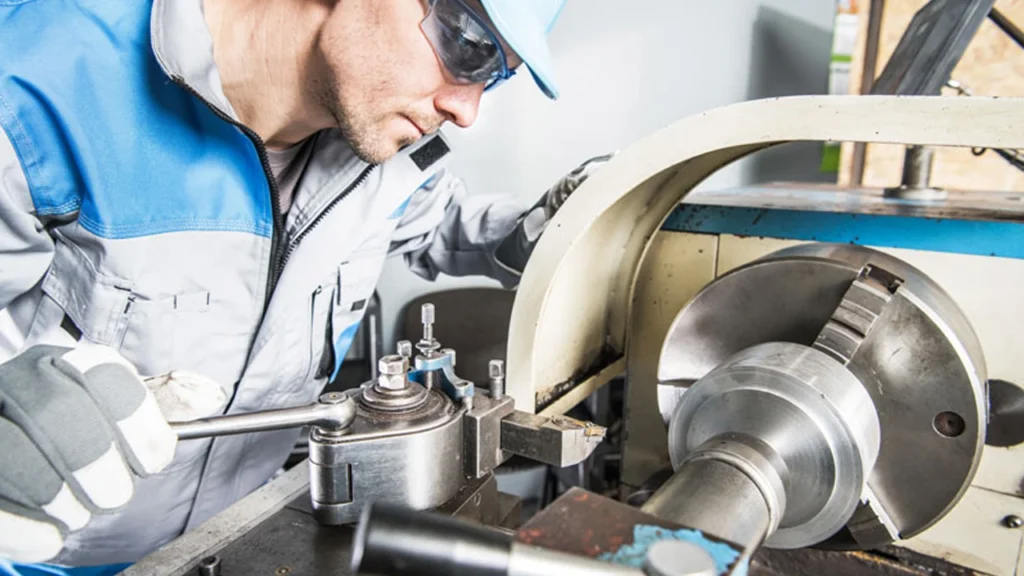
How to Operate a CNC Lathe
Professional Workflow Overview
Operating a CNC lathe is not just about pressing buttons—it’s about precise planning, programming, and setup. Before the machine even moves, a program must tell it what to do. If you’re learning how to operate a lathe in a CNC environment, understanding this sequence is crucial.
The process begins with writing a G-code program. From there, you prepare the machine, load your tools and part, verify offsets, and run the cycle. This structured approach ensures safety, accuracy, and efficiency.
What is G-code and how does it control machine tools?
G-code, short for “Geometric Code,” is a standardized programming language used to control CNC machines. It tells the lathe how to move—where, how fast, and with what tools. Every machining command, from spindle rotation to tool path control, is defined in G-code line by line.
1. Prepare and Load the CNC Program (G-code)
The CNC lathe cannot function without instructions. These come in the form of G-code, which defines every movement: spindle rotation, feed rate, tool path, coolant control, and more.
You can write G-code manually using common commands such as:
G00: Rapid positioningG01: Linear interpolationG76: Threading cycleM03: Spindle ON clockwiseT0101: Call tool 1, offset 1
Alternatively, you can use CAM software like Fusion 360, Mastercam, or Siemens NX to generate toolpaths based on your 3D model.
Once complete, load the G-code into the lathe control via USB, Ethernet, or direct input. Before cutting, always run a dry simulation or graphical preview to check for collisions or logic errors.

2. Machine Startup and Safety Check
Turn on the main power and initialize the CNC system. Perform a zero return (homing) operation to reset all axes. Confirm the emergency stop button, door interlocks, coolant level, and air pressure are functioning properly.
Visually inspect the machine interior for any leftover tools or material. Never bypass safety doors or run the machine while they’re open.
3. Mounting the Workpiece
Secure the raw material in a hydraulic or pneumatic chuck. For longer bars, use a bar feeder or steady rest. Use jog controls to position the turret and tailstock, ensuring clearance during loading.
For critical precision parts, check concentricity and surface alignment using a dial indicator or part probe.
4. Tool Setup and Offset Input
Load your tools into the turret in the correct order based on the program. Typical tools include:
- Turning tool
- Facing tool
- Parting/grooving tool
- Threading tool
- Boring bar
Use the tool setter or manual touch-off method to determine geometry offsets for each tool in both X and Z axes. Input these values into the machine’s tool offset table.
Then set the work offset (e.g., G54), defining the origin point of the part. Usually this is set to the front face (Z0) and outer diameter (X0) of the workpiece.
5. Running the Program
Switch the machine to Auto mode, close the safety doors, and press Cycle Start.
Closely monitor the first few operations—check for correct tool paths, insert contact, chip evacuation, and coolant flow. If anything seems off, press Feed Hold immediately.
Once verified, let the program complete its cycle. For production batches, you can enable looped cycles or automatic part counters.
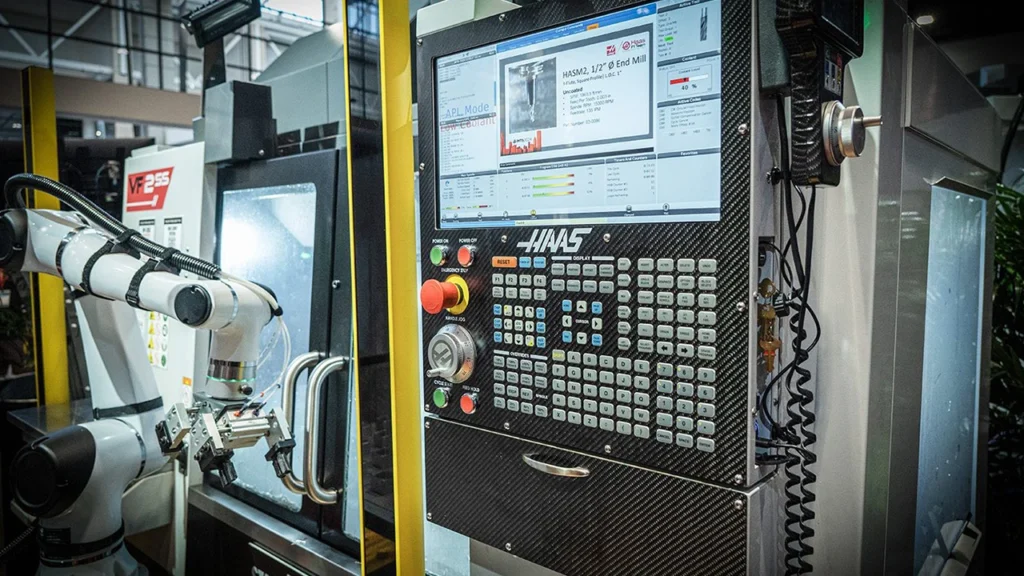
6. Post-Operation and Cleanup
After machining, remove the finished part, blow off chips, and inspect dimensions using a caliper, micrometer, or CMM if needed. Record the measurement for quality control.
Clean the turret, chuck, and working area. Remove worn inserts and log tool life data if the system allows.
CNC Safety and Efficiency Tips
- Always simulate new programs before cutting
- Double-check offsets and tool numbers
- Use correct coolant for each material
- Replace inserts before they dull
- Never leave tools overhanging unnecessarily
- Keep the workspace clean and dry
Mastering how to operate a CNC lathe is about combining thoughtful programming with disciplined setup and monitoring. Once you build confidence, CNC lathes open the door to high-speed, high-precision production with unmatched consistency.
Common Lathe Operations Explained
What Can a Lathe Actually Do?
Whether you’re using a manual or CNC lathe, there are core machining operations that every operator must master. These operations are the building blocks of turning and form the foundation of real-world part production. Knowing how each one works is key to learning how to operate a lathe effectively.
Turning
Turning is the most fundamental lathe operation. In turning, the cutting tool moves parallel to the workpiece’s axis, reducing its diameter to create a cylindrical shape. Rough turning removes bulk material, while finish turning ensures precise diameter and surface finish.
Typical tools: CNMG inserts for rough turning, VNMG or TNMG inserts for finishing; mounted on standard turning toolholders.
Facing
Facing involves cutting across the end face of a rotating workpiece to produce a flat, smooth surface perpendicular to its axis. It’s usually the first step in preparing raw material for further machining. The tool moves radially inward, from the outer edge to the center.
Typical tools: Square or 45°-angled turning tools with CCGT or DCMT inserts; right-hand toolholders for external facing.
Boring
Boring enlarges or refines an existing internal hole. The boring bar is fed into a drilled hole to improve its accuracy, depth, or finish. It’s often used to achieve tighter tolerances than drilling alone and is essential for holes like cylinder bores or bearing seats.
Typical tools: Boring bars with SCLCR or SSSCR-style carbide inserts; mounted in standard boring holders or modular boring systems.
Drilling
Drilling on a lathe is performed using a fixed drill bit held in the tailstock (manual) or a live turret station (CNC). The rotating workpiece pushes against the stationary drill to create axial holes. It’s common to use center drills first to improve accuracy.
Typical tools: Center drills, twist drills, and deep-hole drills; mounted in drill chucks or collet holders.
Threading
Lathe threading creates external or internal threads on shafts or holes. In manual lathes, threading is performed by engaging the lead screw with the spindle. In CNC lathes, threading is done automatically with cycles such as G76.
Typical tools: Laydown threading inserts (60° or 55°), threading bars for internal threads, and standard threading toolholders.
Grooving
Grooving cuts a narrow channel into the part’s outer or inner diameter. It can be used to create reliefs, snap ring grooves, or part-off reliefs. Grooving can be done on the face or diameter depending on the design.
Typical tools: Carbide grooving inserts with narrow, strong profiles; mounted in radial or face grooving toolholders.
Parting (Cut-off)
Parting separates the finished part from the remaining bar stock. The tool feeds perpendicularly into the rotating workpiece until it cuts through. High rigidity and proper speed/feed control are crucial to prevent tool breakage.
Typical tools: Thin parting blades with P-type or Q-type inserts; inserted into dedicated parting toolholders or blade holders.
Taper Turning
Taper turning produces a conical profile where the diameter gradually decreases or increases along the part’s length. It’s achieved manually using the compound rest or automatically using interpolated moves in CNC machines.
Typical tools: CNMG or VNMG turning inserts; used with angled toolholders, compound rest settings, or CNC G01/G32 taper cycles.
Chamfering
Chamfering is the process of creating a sloped edge, typically at 45°, on the outer or inner corners of a part. Chamfers help remove sharp edges, improve part fitment, and reduce stress concentrations.
Typical tools: 45° chamfer tools, profiling inserts, or grooving tools set at an angle.
Knurling
Knurling forms a patterned grip on cylindrical parts such as knobs or handwheels. It is a forming process, not a cutting one—material is displaced using pressure. It requires strong setup and stable feed to avoid slippage or double tracking.
Typical tools: Knurling holders with patterned rollers (diamond, straight, or diagonal); available in scissor-type or push-type formats.
Spinning (Optional Advanced Technique)
Metal spinning is a specialized forming process used to transform a flat disc into a symmetrical hollow shape like a cone or dome. It is used in sheet metal parts like reflectors, cookware, and aerospace nozzles.
Typical tools: Hardened roller tools, forming tools, and rotating mandrels specific to the part shape.
Understanding these 11 core operations is essential for anyone serious about learning how to operate a lathe. Each one has specific tool requirements, cutting parameters, and setup considerations. As you develop your skills, you’ll learn how to combine these operations efficiently for complex part production.
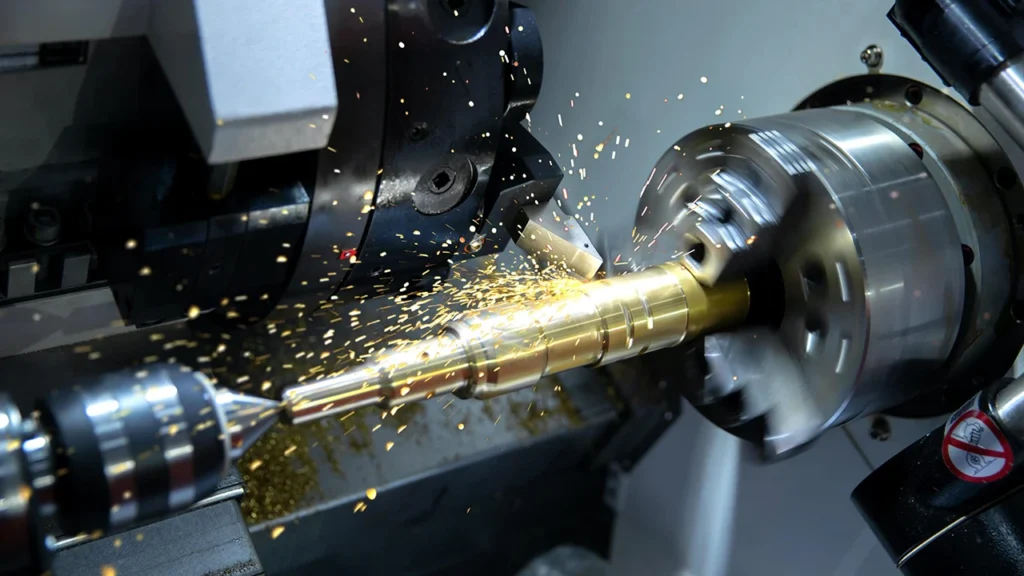
Lathe Setup Best Practices
Why Proper Setup Matters
Before making a single cut, proper setup determines whether your lathe operation will succeed or fail. No matter how advanced the machine or how skilled the operator, skipping setup best practices can lead to poor tolerances, surface defects, tool wear, or even dangerous accidents. Whether you’re working with a manual lathe or CNC system, understanding and applying the correct setup techniques is essential if you want to truly master how to operate a lathe.
Workpiece Alignment
The first rule of any lathe setup is ensuring the workpiece is properly mounted and centered. Even a small deviation in concentricity can affect all subsequent cuts. Use a dial indicator to check for runout after clamping the part in a 3-jaw or 4-jaw chuck. For longer parts, support the opposite end using a live center in the tailstock or a steady rest.
In CNC lathes, you may use probing systems to automate alignment. For manual lathes, take your time—precision begins here.
Tool Center Height and Positioning
Setting the cutting tool at the correct center height is critical for both performance and safety. A tool set too high or low can cause poor surface finish, excessive wear, or tool breakage. Use a center gauge or a simple metal ruler to verify the tool is aligned to the spindle axis.
In manual lathes, use shims under the tool or adjust the toolholder height if available. On CNC lathes, alignment is achieved during the tool offset measurement process. Make sure each tool is secured tightly in the holder to prevent vibration or deflection during cutting.
Spindle Speed and Feed Rate Selection
Selecting the right spindle speed (RPM) and feed rate depends on several factors: material type, diameter of the part, depth of cut, and the specific operation. Refer to speed and feed charts for guidance, or use cutting data provided by the tool manufacturer.
As a general rule:
- Softer materials (aluminum, brass) → Higher RPM
- Harder materials (stainless steel, titanium) → Lower RPM, slower feed
- Deeper cuts → Slower speeds and lighter feeds
In CNC systems, all of these values are entered into the program (via S and F codes). In manual lathes, you’ll set speeds using gear levers and control feed manually.

Tool Clearance and Safety Zones
Always double-check for tool clearance before running your machine—especially in CNC. During rapid moves or multi-tool programs, make sure there are no obstructions in the turret path or tailstock zone.
If you’re running a CNC dry-run simulation, keep the door open (if safety allows) and your finger on the Feed Hold button. Always verify that coolant nozzles are aimed correctly and that chip evacuation is unobstructed.
Lubrication, Coolant, and Cleanliness
A clean machine is a safe and accurate machine. Before and after setup:
- Wipe down chuck and tool surfaces
- Apply way oil to slideways (manual machines)
- Ensure coolant levels are sufficient
- Clean chips from the bed, turret, and guards
Use the right coolant for your material—water-soluble coolant for general cutting, straight oil for tough materials or threading.
Checklist Before Running the Machine
- Here’s a quick pre-run checklist every machinist should follow:Workpiece is securely clamped
- Chuck key removed
- Tools properly mounted and tightened
- Spindle speed and feed rate confirmed
- Tool offsets and work offsets set correctly (CNC)
- Tailstock locked (if used)
- Safety doors closed
- Emergency stop is accessible
A proper setup doesn’t just help avoid problems—it makes your entire operation smoother, faster, and more professional. If you want to learn how to operate a lathe like an expert, this is where you build the habit of excellence.
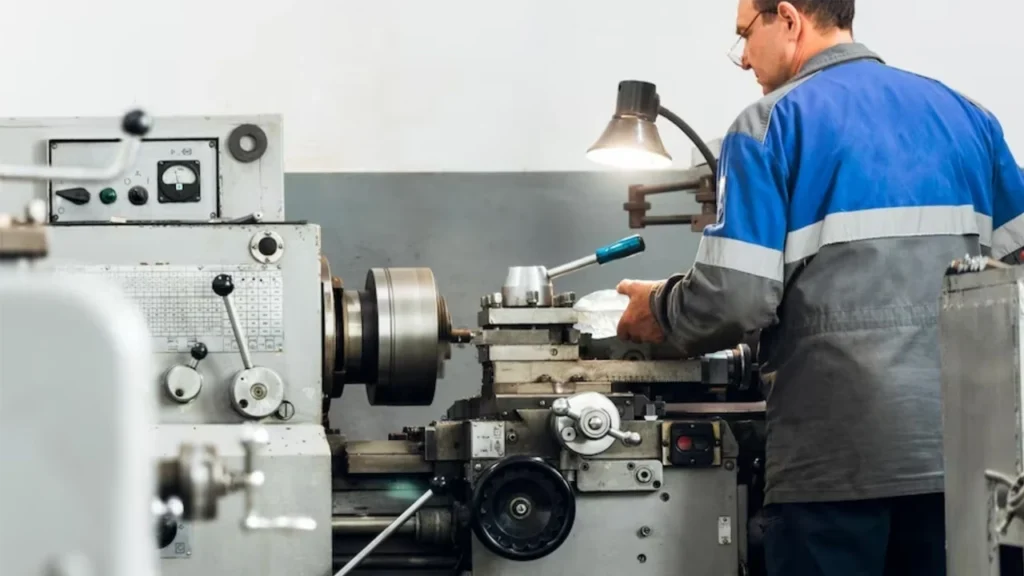
Maintenance and Troubleshooting
Why Maintenance Matters
If you want to operate a lathe that delivers consistent precision, minimal downtime, and long tool life, regular maintenance isn’t optional—it’s essential. Whether you’re working with a manual or CNC lathe, routine checks and preventative care are key to maximizing performance and avoiding costly machine failures. Learning how to operate a lathe also means knowing how to keep it in peak condition.
Daily, Weekly, and Monthly Maintenance Tasks
Creating a structured maintenance schedule helps extend your machine’s life and catch potential issues early. Here’s how to divide the tasks:
Daily Tasks:
- Clean chips and debris from the bed, tool post, and chuck
- Wipe down exposed surfaces with rust-preventative oil
- Check oil levels in lubricators (manual or automatic)
- Confirm proper coolant flow and level
- Inspect tools for wear or chipping
Weekly Tasks:
- Check gibs for tightness and adjust if needed
- Test backlash on lead screws or ball screws
- Inspect belts or drive mechanisms for tension and wear
- Examine spindle condition and noise during rotation
- Lubricate guideways (if not automatic)
Monthly Tasks:
- Drain and replace dirty coolant
- Check chuck jaws for wear and alignment
- Tighten electrical connectors and grounding points
- Inspect tailstock and carriage movement for uniformity
- Run a full diagnostic on CNC control systems (if applicable)
Staying disciplined with these checks will save you from unexpected breakdowns and ensure reliable part quality.
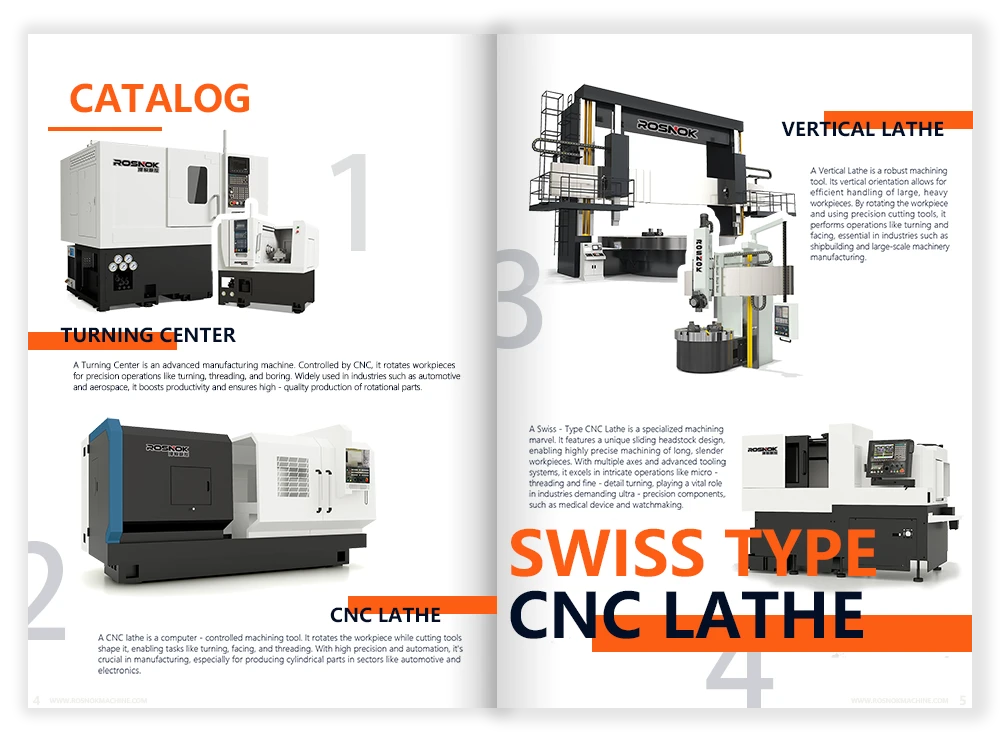
Common Lathe Issues and How to Solve Them
Even with proper care, problems may still arise. Here are some of the most frequent issues operators encounter—and what you can do about them:
1. Poor Surface Finish
Cause: Dull tools, excessive feed rate, worn guideways
Fix: Replace insert, reduce feed, check alignment of tool and tailstock
2. Vibration or Chatter
Cause: Loose tool setup, lack of rigidity, unsupported workpiece
Fix: Secure toolholder, use tailstock or steady rest, reduce depth of cut
3. Tapered Workpieces
Cause: Misaligned tailstock, worn bed, uneven cutting pressure
Fix: Realign tailstock, inspect guideways, reduce tool pressure
4. Inaccurate Threading
Cause: Incorrect lead screw engagement, tool geometry mismatch
Fix: Double-check threading pitch, verify insert profile, re-cut
5. Overheating or Burning Chips
Cause: Incorrect speed/feed, no coolant, improper tool material
Fix: Lower RPM, apply coolant, switch to coated insert for better heat resistance
Spare Parts and Wear Components
To maintain uptime, keep a small inventory of high-wear components and consumables, such as:
- Inserts and toolholders
- Chuck jaws and keys
- Coolant and filters
- Way oil and lubricants
- Tailstock centers and bushings
- Fuses, belts, and spindle drive components (for CNC)
Choose high-quality, compatible parts—at Rosnok, we use Japanese and Taiwanese components for durability and precision.
Proactive Maintenance = Professional Operation
Preventive maintenance not only prevents breakdowns but also strengthens your credibility as an operator. If you truly want to learn how to operate a lathe like a professional, treat it like a high-performance machine—not just a tool.
Manual vs CNC Lathe: Which One Should You Start With?
Understand the Learning Curve
If you’re new to machining, one of the first decisions you’ll face is whether to begin with a manual lathe or a CNC lathe. Each machine type has its strengths, challenges, and learning paths. Choosing the right one depends on your goals, environment, and how you prefer to build skills. Since this guide focuses on how to operate a lathe, understanding the difference is critical to your long-term success.
Advantages of Starting with a Manual Lathe
For absolute beginners, manual lathes offer several benefits that make them an excellent entry point:
Hands-on Understanding
You physically control every feed, cut, and movement. This teaches you the core principles of cutting mechanics, tool pressure, and chip formation in real time.
Simpler Setup
Manual lathes don’t require programming knowledge, making them more approachable. You can focus on tool geometry, speed/feed, and setup accuracy without worrying about G-code.
Cheaper to Learn On
Manual lathes are generally lower in cost, and mistakes are less likely to cause expensive damage compared to CNC equipment.
Visual and Sensory Feedback
You see and feel how the machine responds. This tactile experience helps build a “machinist’s intuition” for feed resistance, tool wear, and material behavior.
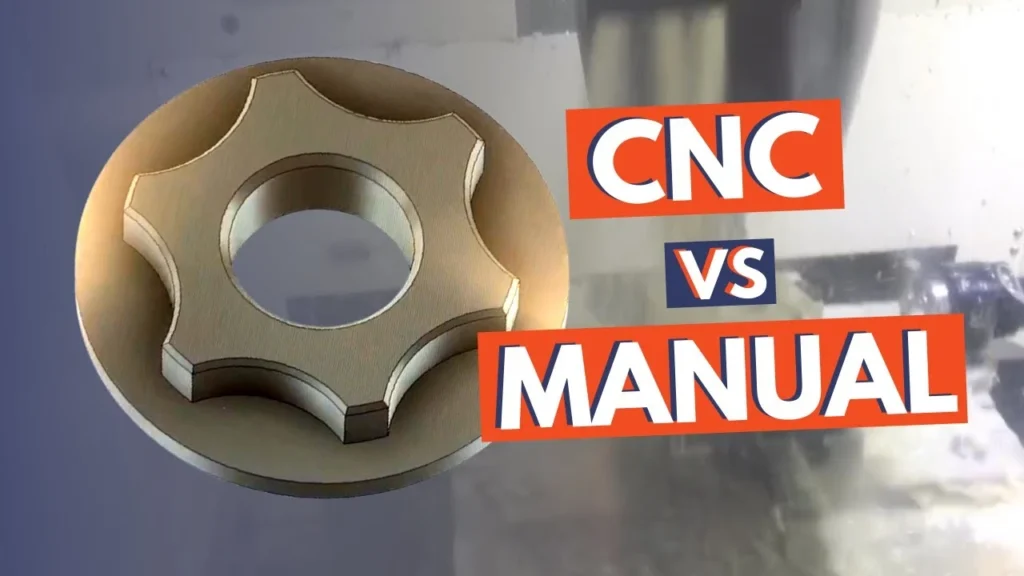
Why CNC Might Be Better for Some Beginners
That said, some users may benefit more by jumping directly into CNC—especially if their work or future plans are production-based.
Automation & Repeatability
CNC lathes can produce identical parts with micron-level accuracy at high volume. Once the program is perfected, execution becomes consistent and efficient.
In-Demand Skillset
CNC programming and operation are essential in modern manufacturing. Starting with CNC gives you a head start on industry-relevant skills like G-code, CAM software, and automation logic.
Safety Built-in
Many CNC machines come with interlocks, auto shutdown, and dry-run simulations, reducing the chances of human error causing accidents.
Complex Capabilities
Multi-axis CNC lathes can handle part geometries that would be difficult or impossible on a manual lathe, opening the door to high-value, high-precision work.
A Hybrid Approach Is Ideal
In reality, the best machinists understand both. Starting on a manual lathe helps build a deep mechanical foundation. Transitioning to CNC afterward allows you to scale that knowledge with digital control.
Even many professional CNC programmers started with manual machines to understand the “why” behind the code. At Rosnok, we encourage learning both methods—because precision isn’t just about technology, it’s about mastery.
Final Recommendation
If you’re a hobbyist or craftsman wanting to build a strong foundation:
Start with a manual lathe
If you’re aiming for a professional path in industrial or production machining:
Learn CNC early—but don’t skip manual basics
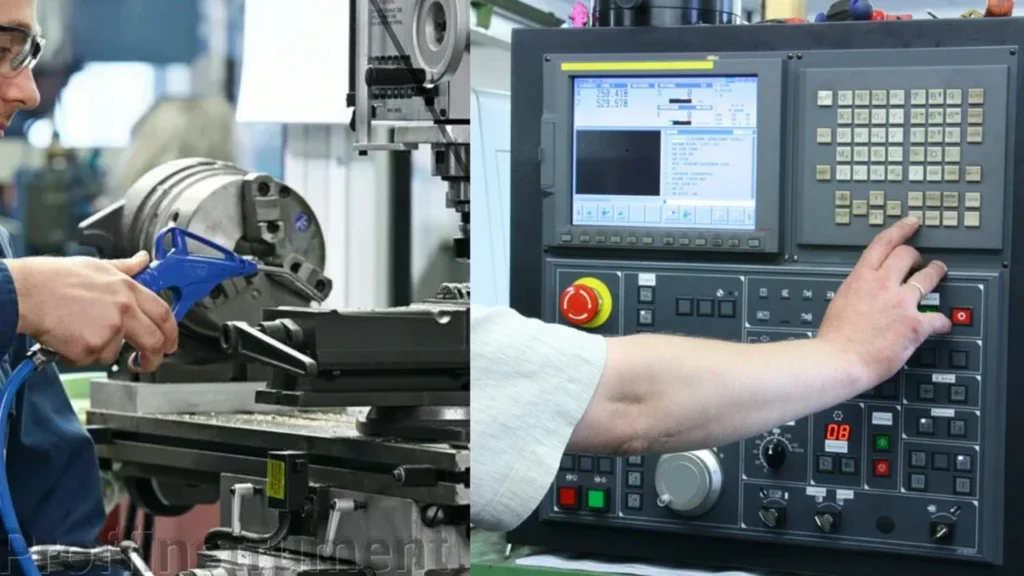
Pro Tips to Improve Lathe Operation
Even if you’ve learned the basics of how to operate a lathe, becoming a skilled machinist takes more than following procedures. It’s about fine-tuning your technique, learning from real-world experience, and avoiding costly mistakes. This section offers advanced but beginner-friendly insights to help you improve your performance and machine output.
Avoiding Beginner Mistakes
The best way to become better faster? Learn from mistakes—especially the ones you don’t have to make yourself. Here are the most common beginner errors, and how to avoid them:
Skipping Tool Height Setup
Tools not set at spindle center cause chatter, poor finish, or even tool breakage. Always use a center finder or the “rule-of-thumb” ruler method.
Forgetting the Chuck Key
Leaving the chuck key in can result in dangerous accidents. Make it a habit: remove it immediately after tightening—no exceptions.
Wrong Speeds and Feeds
Using the same spindle speed for different materials is a fast track to tool wear or poor finish. Use charts or manufacturer recommendations.
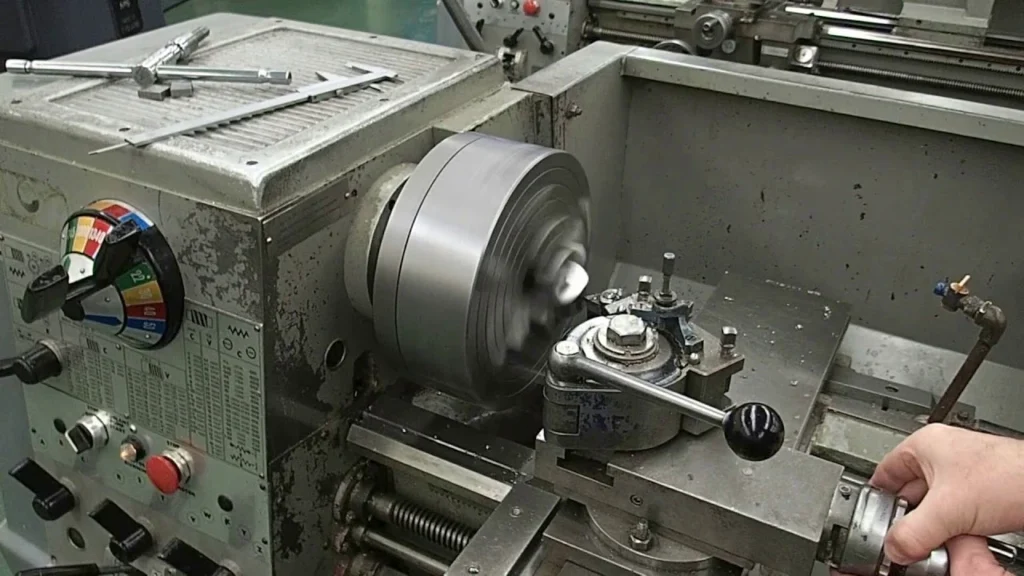
Ignoring Workpiece Support
Long parts need support from the tailstock or steady rest. Unsupported stock will flex and lead to taper or inaccuracy.
Tightening Too Much
Over-tightening the chuck or toolholder can deform thin-walled parts or break inserts. Snug and secure—not overkill.
Pro Tip: Keep a laminated checklist by the machine as a visual reminder until these steps become second nature.
Improving Surface Finish and Accuracy
If your part feels rough to the touch, or dimensions are slightly off—don’t worry. Here’s how the pros get that clean, smooth, mirror-like finish and tight tolerance:
Use Sharp Inserts
Dull tools don’t cut—they rub. Replace inserts regularly and choose the right grade and chipbreaker for the material.
Fine-Tune Speed & Feed
A smoother finish often comes from higher spindle speed and lighter feed rate. But balance is key—too fast causes heat and smearing.
Take Light Finishing Passes
Always leave a small amount (0.2mm–0.5mm) for the finishing cut. Use a slower feed and make one clean pass without stopping.
Use Coolant or Air Blast
Coolant helps reduce tool temperature and clears chips. For aluminum or plastics, an air blast may improve finish without contamination.

Check Tool Overhang
Minimize how far your tool sticks out from the holder. Shorter overhang means more rigidity, less vibration, and a cleaner cut.
Pro Tip: For tight tolerances, measure while the part is still clamped—removal can cause spring-back or thermal changes.
Efficient Material Removal Techniques
When you want to maximize productivity—especially in roughing operations—knowing how to remove material quickly without sacrificing quality is essential.
Use Proper Roughing Inserts
Use stronger, negative rake inserts like CNMG with high chip resistance. They’re built to withstand heavy cuts and higher feed rates.
Optimize Depth of Cut (DOC)
Take deeper DOCs (2–4mm) during roughing to reduce the number of passes. Keep consistent chip load to prevent tool overload.
Use the Right Chipbreaker
A good chipbreaker breaks long chips into smaller pieces, improving surface finish and reducing chip entanglement.
Apply Flood Coolant
Especially for steel or stainless steel, flood coolant helps with heat dissipation and tool life during aggressive cuts.
Use Constant Surface Speed (CSS) on CNC
Set your CNC lathe to G96 (CSS) so the spindle automatically adjusts speed relative to diameter—this maintains optimal cutting conditions as the tool moves inward.
Pro Tip: In manual lathes, gradually reduce RPM as the diameter decreases to mimic CSS behavior.

Conclusion: How to Operate a Lathe
Final Thoughts
Learning how to operate a lathe is not just about running a machine—it’s about mastering the relationship between material, tool, and process. Whether you’re starting with a manual lathe or programming a CNC system, every turn, every cut, and every measurement is a step forward in building your skills and confidence.
The lathe is one of the most versatile and foundational tools in metalworking. By understanding its components, operations, setup procedures, and maintenance needs, you’ve already laid the groundwork for becoming a competent and capable machinist.
But knowledge alone isn’t enough—it’s repeated practice that sharpens precision and builds intuition. Every chip you make brings you closer to mastery.
Next Steps for Practice and Progress
To continue improving and turning knowledge into action, follow these steps:
- Practice basic operations like turning, facing, and drilling on safe stock material
- Use your own logbook to track speeds, feeds, tool wear, and results
- Study tool catalogs to understand insert geometries and selection
- Join machining forums or local workshops to learn from experienced machinists
- Try programming simple CNC cycles in a simulator if you’re planning to transition to automation
- Set goals—like creating a precision part within 0.01 mm tolerance, or completing a threading job without errors
- Revisit this guide whenever you’re troubleshooting or unsure—think of it as your operator’s companion
With every project, you’ll deepen your understanding, solve new problems, and expand your capabilities. That’s how professionals grow—from knowing how to operate a lathe, to knowing how to machine with confidence, precision, and purpose.






